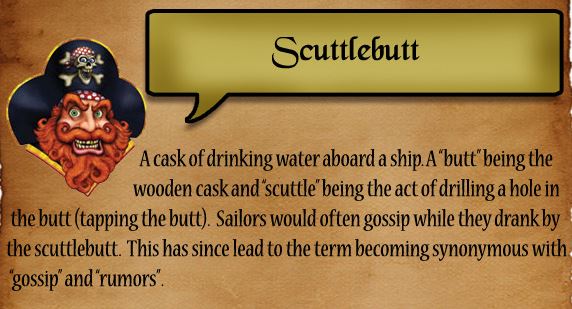
The anchor (both with and without the entwined rope) is a traditional heraldic device used in ancient British coats of arms. A variation of the seal had been in use by the Lord High Admiral of Scotland about a century earlier. The fouled anchor was adopted as the official seal of Lord High Admiral Charles Lord Howard of Effingham during the late 1500s. The fouled (rope- or chain-entwined) anchor so prevalent in our Navy's designs and insignia is a symbol at least 500 years old that has it origins in the British traditions adopted by our naval service. The real Flying Dutchman is supposed to have set sail in 1660. The cursed spectral ship sailing back and forth on its endless voyage, its ancient white-hair crew crying for help while hauling at her sail, inspired Samuel Taylor Coleridge to write his classic "The Rime of the Ancient Mariner," to name but one famous literary work. The tale of the Flying Dutchman trying to round the Cape of Good Hope against strong winds and never succeeding, then trying to make Cape Horn and failing there too, has been the most famous of maritime ghost stories for more 300 years. One superstition has it that any mariner who sees the ghost ship called the Flying Dutchman will die within the day. The term is not modern, however, but dates to the 18th century and comes from the Hindi word dungri, for a type of Indian cotton cloth.Īlthough a fathom is now a nautical unit of length equal to six feet, it was once defined by an act of Parliament as "the length of a man's arms around the object of his affections." The word derives from the Old English Faethm, which means "embracing arms." The term comes from the Flemish town of Duffel near Antwerp, and denotes a rough woolen cloth made there. Also spelled duffel, it referred to his principal clothing as well as to the seabag in which he carried and stowed it. First used by seamen, it has only been traced back to the turn of the century.Ī name given to a Sailor's personal effects. Here's a drinking expression that seems to have its origins in sea freight, where cargoes are lowered into the hatch. But no one really knows the origin of this term, which was in use at least back to 1700.


Some experts say dogwatch is a corruption of dodge watch and others associate dogwatch with the fitful sleep of Sailors called dog sleep, because it is a stressful watch. The dogwatches are only two hours each so the same Sailors aren't always on duty at the same time each afternoon.

With the passing of time the coxswain became the helmsman of any boat, regardless of size.Ī dogwatch at sea is the period between 4 and 6 p.m, the first dogwatch, or the period between 6 and 8 p.m., the second dog watch. The term has been in use in England dating back to at least 1463. This widely used term has its origins in the document issued to a ship showing that the port it sailed from suffered from no epidemic or infection at the time of departure.Ī coxswain or cockswain was at first the swain (boy servant) in charge of the small cock or cockboat that was kept aboard for the ship's captain and which was used to row him to and from the ship. The ship's crew then started referring to the stack as the "Charley Noble." It seems that Captain Noble, discovering that the stack of his ship's galley was made of copper, ordered that it be kept bright. Bright it should be and work it is.Ĭharlie Noble is an "it," not a "he." A British merchant service captain, Charles Noble, is said to be responsible for the origin, about 1850, of this nickname for the galley smokestack. These recruits trained in "boot" camps.īrightwork originally referred to polished metal objects, and bright woodwork to wood which was kept scraped and scrubbed, especially topside. The list was kept at the binnacle.ĭuring the Spanish-American War, Sailors wore leggings called boots, which came to mean a Navy (or Marine) recruit. In the eighteenth century and probably before, a list was given to the officer or mate of the watch, containing the names of men unable to report for duty. A binnacle was the stand on which the ship's compass was mounted. The term is also used more generally to describe seamen as compared with officers, in phrases such as "he sailed before the mast."Ī ship's sick-list.

Literally, the position of the crew whose living quarters on board were in the forecastle (the section of a ship forward of the foremast).


 0 kommentar(er)
0 kommentar(er)
